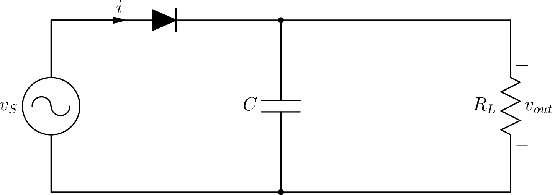 |
It can be seen from Figures 82 and 84 that the waveform vout is not very smooth. For many applications it is desired to have a much smoother DC waveform, and so a filtering circuit is used. We will consider the filtered half-wave rectifier of Figure 86, and leave the filtered full-wave rectifiers up to you to work out (not hard-see lab).
The waveform produced by this filtered half-wave rectifier is shown in Figure 87, illustrating the ripple.
Here, ripple is defined as the difference between the maximum and minimum voltages on the waveform, Figure 88 (i.e. peak-to-peak).
The (peak-to-peak) ripple factor r
is defined as
We now explain how to calculate (approximately) Vrpp and VDC.
Think of the ripple waveform as being approximated by a triangular
waveform (Figure 89),
so that

Exercise.
Show that Vrpp in the case of a full-wave rectifier
is given by
ANU Engineering - ENGN2211